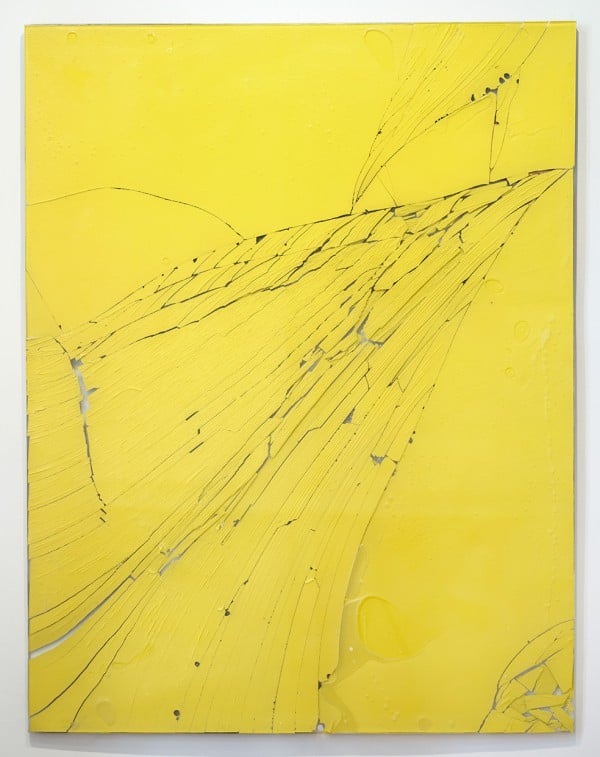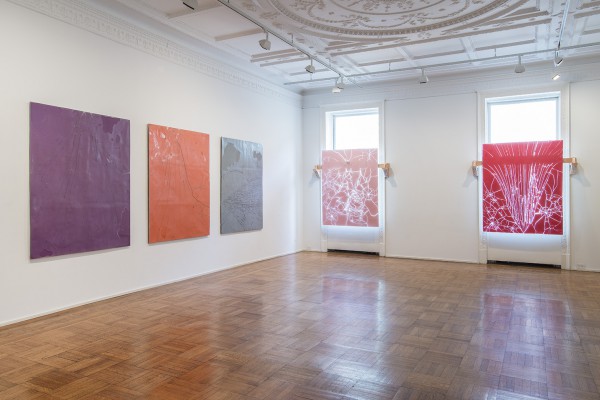Galleries
Luca Dellaverson’s Art of Undoing at Jack Tilton Speaks for a New Generation of American Artists
What are young American artists thinking?

What are young American artists thinking?

Benjamin Genocchio

Luca Dellaverson’s energetic, colorful, complicated show at Jack Tilton tells you why art and artists matter.
Galleries, more than anywhere else, are where artists put themselves on the line, and show new works fresh from the studio. Galleries don’t charge admission precisely for this reason.
“Exuberance is beauty,” William Blake said, and Luca Dellaverson’s show is nothing if not exuberant. This 28-year-old artist has energy, ideas, ambition, and desire, along with an admirable sense of respect of art world elders and history. His paintings abound with references to literary, artistic, and pop culture figures ranging from Robert Graves, Cady Noland and David Hammons to Jurassic Park references.
But in many ways the content is not the emphasis here. Rather it’s the form—what we think of as the process—that is on display in these pictures made of boiling hot epoxy resin poured into silicon molds of stretched canvasses and then backed up with colored mirrors which crack, splinter, and buckle during the curing process. The artist intervenes to help create the final look, often painting a coat of gesso on top, then sanding it away.

Luca Dellaverson, Untitled (2015).
Photo: Courtesy of Tilton Gallery.
The artist hangs his pictures on the wall, asking us to read them as paintings. And yet everything to do with painting is here except actual paint. So what are we looking at, exactly? Process, abstraction, a field of color. Nothing terribly new about any of that, given Minimalism, Post-Minimalism, and the current vogue for process-based abstraction.
More interesting is the element of undoing in this work, the way in which the artist makes and then breaks down his source connections, so to speak, undoing and defacing conventional ideas of painting, beauty, form, and structure.
This sense of undoing source images, reference points, and subject matter (which include Russian prison tattoos, erotic imagery, quotes from books, other artist’s work, even landscape painting), tilts the work away from Minimalism, which is more about doing, even if the gestures are slight, and puts the artist in the conceptual art camp. He is a thinker, as much as a maker—a thinker who puts ideas into action through the act of undoing.

Installation shot of “Luca Dellaverson: Fight This Generation” at Tilton Gallery.
Photo: Courtesy of Tilton Gallery.
Beyond the paintings, which vary in form and scale, and process, the artist is experimenting with functioning video screens locked in epoxy molds which show popular movies. The epoxy casing distorts the images so there is nothing to look at, though the soundtracks are turned all the way up.
I confess I found this confusing, especially as the sound drifted throughout the building and interfered with my desire to engage his other work, but then again, this was sort of the point, to put these video works in your face, to bother and distract you, undoing any peace of mind.
The art of undoing, an art of confrontation, an art of disintegrating historical, social, artistic and cultural reference points with no discernible organizational logic—call it an information continuum—is not without risks, especially for young artists looking to make their way in the art world. But it’s also a mark of ambition, a cry for attention in a crowded field.
Dellaverson delivers on the promise of his show’s title, “Fight This Generation,” which is a cri de coeur to Millennials to get up, get out, and fight for a different future.
You want a glimpse of what that might look like, good and bad, done and undone, then come and see this show.